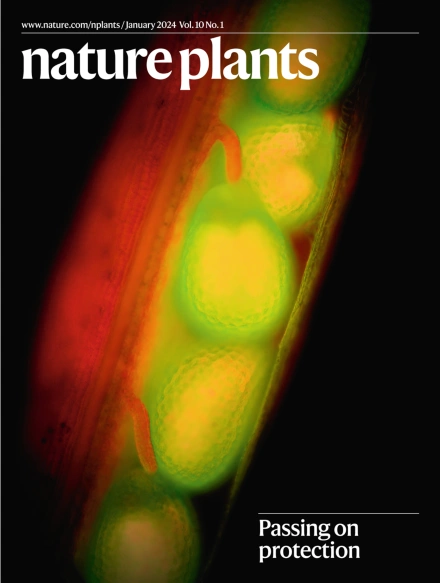The BRUTUS iron sensor and E3 ligase facilitates soybean root nodulation by monoubiquitination of NSP1
IF 15.8
1区 生物学
Q1 PLANT SCIENCES
引用次数: 0
Abstract
Legumes form root nodules with symbiotic nitrogen-fixing rhizobacteria, which require ample iron to ensure symbiosis establishment and efficient nitrogen fixation. The functions and mechanisms of iron in nitrogen-fixing nodules are well established. However, the role of iron and the mechanisms by which legumes sense iron and incorporate this cue into nodulation signalling pathways remain unclear. Here we show that iron is a key driver of nodulation because symbiotic nodules cannot form without iron, even under conditions of sufficient light and low nitrogen. We further identify an iron optimum for soybean nodulation and the iron sensor BRUTUS A (BTSa) which acts as a hub for integrating iron and nodulation cues. BTSa is induced by rhizobia, binds to and is stabilized by iron. In turn, BTSa stabilizes and enhances the transcriptional activation activity of pro-nodulation transcription factor NSP1a by monoubiquitination from its RING domain and consequently activates nodulation signalling. Monoubiquitination of NSP1 by BTS is conserved in legumes to trigger nodulation under iron sufficiency. Thus, iron status is an essential cue to trigger nodulation and BTSa integrates cues from rhizobial infection and iron status to orchestrate host responses towards establishing symbiotic nitrogen fixation. The authors report that iron binds to and stabilizes the iron sensor BRUTUS A (BTSa), which monoubiquitinates the pro-nodulation transcription factor NSP1a to increase its stability and transcriptional activity, thereby regulating nodulation in legumes.


BRUTUS铁传感器和E3连接酶通过NSP1的单泛素化促进大豆根结瘤
豆科植物与共生固氮根瘤菌形成根瘤,这需要充足的铁来确保共生关系的建立和有效的固氮。铁在固氮根瘤中的作用和机制已经很好地确立。然而,铁的作用以及豆科植物感知铁并将这一线索纳入结瘤信号通路的机制仍不清楚。在这里,我们发现铁是结核形成的关键驱动因素,因为共生结核不能在没有铁的情况下形成,即使在充足的光照和低氮条件下也是如此。我们进一步确定了大豆结瘤的最佳铁和铁传感器BRUTUS A (BTSa),它作为整合铁和结瘤信号的枢纽。BTSa由根瘤菌诱导,与铁结合并被铁稳定。反过来,BTSa通过环域单泛素化来稳定和增强促结瘤转录因子NSP1a的转录激活活性,从而激活结瘤信号。在铁充足的情况下,BTS对NSP1的单泛素化在豆科植物中是保守的,从而引发结瘤。因此,铁状态是触发结瘤的重要线索,BTSa整合了来自根瘤菌感染和铁状态的线索,以协调宿主对建立共生固氮的反应。
本文章由计算机程序翻译,如有差异,请以英文原文为准。
求助全文
约1分钟内获得全文
求助全文
来源期刊

Nature Plants
PLANT SCIENCES-
CiteScore
25.30
自引率
2.20%
发文量
196
期刊介绍:
Nature Plants is an online-only, monthly journal publishing the best research on plants — from their evolution, development, metabolism and environmental interactions to their societal significance.
 求助内容:
求助内容: 应助结果提醒方式:
应助结果提醒方式:


